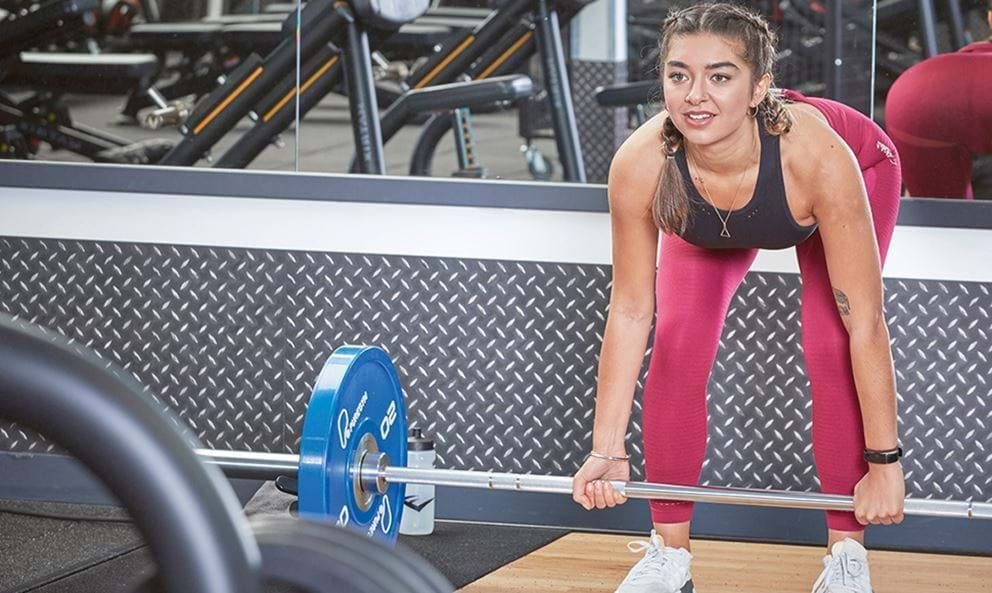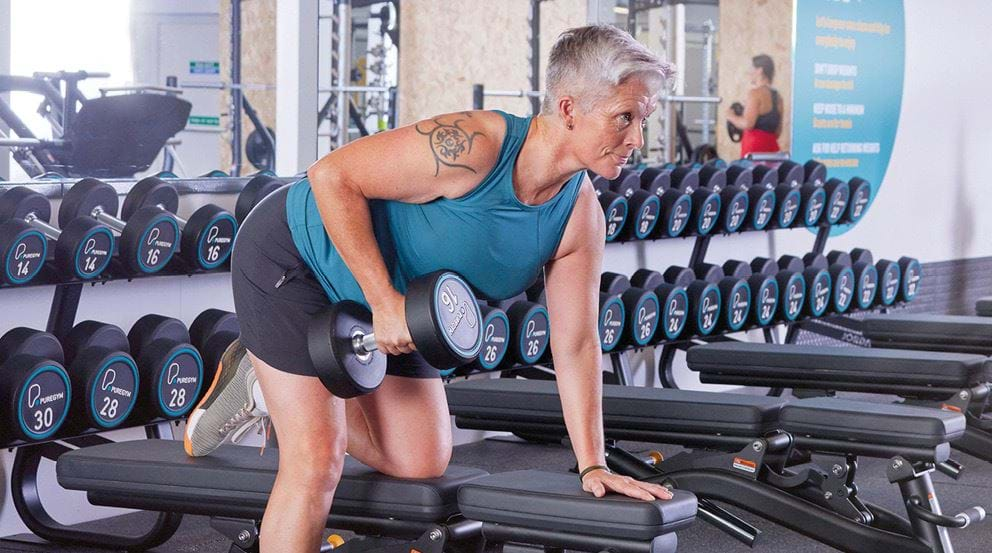Strength Training: What is it and why should you do it?

What Are Strength Exercises | Strength Training FAQs | How To Start Strength Training | Strength Training Workout Programme | Tips & Advice
Page last updated: 3rd July 2023
To keep healthy and fit, the NHS recommends completing muscle-strengthening exercises at least twice a week and, thanks to a wealth of fantastic benefits, more and more people are focusing on strength training to tone up and boost their physical (and mental) wellbeing.
But what is strength training and how can you integrate it into your weekly routines? Read on to learn the answers to these questions and more.
What Are Strength Training Exercises?
Strength training is the process of lifting heavy weights at low reps, with the specific aim of getting stronger and building denser muscles. Strength training is a type of resistance training but with the specific goal of boosting your strength and ability to (for example) lift heavier weights.
Salma Rouf, Personal Trainer at PureGym Leeds City Centre North describes how strength training works: "it requires a much larger stimuli than muscle growth or endurance-based lifting. This puts more stress on your muscles, and causes tiny micro-tears within them. These micro-tears are necessary for your muscles to get stronger but require adequate rest (and nutrition) for your body to repair and rebuild your muscle fibres."
Strength Training FAQs
Does Strength Training Burn Fat?
Strength training can help to burn fat in two ways. The first is that having more muscle in your body (built through strength training) can increase your metabolic rate, meaning you burn more calories throughout the day, even at rest.
Secondly, while aerobic training is generally considered the most impactful exercise style for burning fat, studies have shown that strength training can be just as effective. For example, this 2012 study compared the effects of aerobic training, resistance training, and a combination of both on body mass and fat mass in overweight and obese adults. The results indicated that resistance training alone or combined with aerobic training led to significant reductions in body mass and fat mass while increasing lean body mass (i.e. burning fat while building muscle).
However, when fat loss is a goal, it's important to remember that creating a calorie deficit through your diet is more effective than trying to burn fat through exercise. Learn more about creating a calorie deficit here.
Does strength training increase hypertrophy (aka grow muscle)?
Hypertrophy refers to the increase in size or growth of an organ or tissue, particularly muscle tissue. During strength training activities like lifting weights, muscles experience microscopic damage and tiny tears to the muscle fibres. Rebuilding and repairing these tears is what stimulates muscel growth.
All strength training has the potential to increase hypertrophy but if you are hoping to build noticeable mass, you'll need to tailor the exercises, reps, and sets accordingly. Check out our bodybuilding workout plan for more on this.
How many calories does strength training burn?
The primary goal of strength training is usually building muscle and boosting strength. However, it does also contribute to calorie burning and can continue to do so after your workout thanks to an increased metabolic burn rate.
How many calories exactly can depend on how intense your workout is, how long you train for, which exercises you choose and your individual body composition. However, Harvard Health Publishing states that strength training can burn around 112-223 calories per 30 minutes, depending on factors like body weight and intensity of the workout.
What are the benefits of strength training?
While it may seem obvious that one of the key benefits of strength training is, well, building strength, there's a host of other fantastic benefits that make this approach so popular with a wide range of gym-goers and fitness fans. Here are some of our favourites:
- Increased muscle strength and endurance: as the name suggests, strength training boosts strength, which in turn can improve performance in a range of activities from carrying the shopping or lifting furniture through to athletics and sports[1].
- Bigger muscles: as strength training promotes muscle growth (hypertrophy) it can lead to larger muscles and improved definition, so is perfect if you're looking to tone and sculpt your body.
- Calorie burning: muscles are more metabolically active than fat, meaning they burn more calories, even at rest, meaning strength training can support weight management and fat loss.
- Healthier bones: as we get older, we typically experience age-related bone loss and weakness - strength training keeps bones strong and healthy, slowing down this loss and reducing the risk of fractures and osteoporosis.
- Healthier joints: strengthening the muscles around the joints provides greater stability and support, helping to reduce the risk of injuries and osteoarthritis.
- Improved mental health: strength training can reduce symptoms of anxiety and depression[2], boost self esteem and body image, improve mood and increase cognitive function.
- A longer, higher quality life: studies have shown that regular strength training can be associated with increased longevity and a generally healthier life, with higher independence, improved mobility, increased functional capacity and a reduced risk of diseases like cancer[3,4].
How To Start Strength Training
If you're not sure where to start with strength training, then a good start is familiarising yourself with the weights section of your gym. You can start with weights machines, as these provide more support as you learn the right movements, and work your way up to free weights like dumbbells and barbells. Check out our weight training for beginners page for a step-by-step guide, or book in for one of our strength classes to improve strength whilst also fitting in a cardio workout to keep you sweating.
A Strength Training Programme Workout Plan For You To Try:
Ready to start strength training? Salma has provided the following workout plan as an example of strength training exercises you could try:
Standing barbell military press - 3 sets of 5 reps, 2-5 minute rest
Load the barbell in the squat rack, so that the bar is positioned at about upper-chest height. With shoulders back, take hold of the bar at about shoulder-width, with palms facing outward. Unrack the weight, keeping your abs tight and back straight, but not hyper extended. Press the weight up in a controlled manner, exhaling as you press, and inhaling as you lower. Try to keep the rest of your body still and allow the shoulders to handle the weight. Press the weight from your upper chest. Don't press it behind your head as this increases your risk of injury.
Barbell back squat - 5 sets of 5 reps, 2-5 minute rest
Stand with feet shoulder- width apart and the bar on your upper back. Look straight ahead, take a deep breath in and tighten your ab muscles. Then bend your knees and sink your hips back while lowering your hips towards the floor until it sinks just below the knees. Pause. Drive your hips up to return to the starting position.
To get the most out of your barbell squats, Salma recommends that you:
- Keep elbows tucked
- Keep head neutral throughout (don't look up!)
- Bend the knees and sit back into the squat
- Keep the knees strong, and don't let them buckle inwards
- The aim is to achieve a full range of motion, but this can look different from person to person based on lever lengths and flexibility, so consider hiring a personal trainer to optimise your form
Deadlifts - 3 sets of 5 reps, 2-5 minute rest
Place feet in line with your hips. Bend the knees, hinge at the hip and keep the back straight. Grip the bar, keeping the arms shoulder width apart. Engage yours lats (upper back muscles), and drive your legs back up into a standing position. Keeping the bar close to your body at all times, slowly lower the bar back to the floor.
Flat barbell bench press- 3 sets of 5 reps, 2-5 minute rest
Grab the bar with your hands slightly wider than shoulder-width apart.
Position yourself with your upper back and hips on the bench, your feet firmly on the floor, and a slight arch in your lower back. Think about pulling your shoulder blades back and down, pushing into the bench. Flex your lats and abs, and squeeze your shoulder blades together as you gently breathe in and bring the bar towards your sternum, being sure to not bounce the bar out of the bottom of the movement.
Salma says: "The aim is for your hands to be in line with your elbows at the bottom of the movement, which helps with generating force to help drive the bar up. Breathe out as you drive up and press the bar back to your starting position."
Tips And Advice For Strength Training
Preparation: it’s really important to warm up before strength training and to cool down afterwards. You’re putting your muscles under a lot of strain so preparing them in the right way will help to prevent injury. Your warm up should be tailored to you and the workout you're doing but as a general guideline, you can try some dynamic stretches before lifting to warm up, and include some stretches to cool down afterwards.
Intensity: Build up your weights gradually – if you start on a really heavy weight straight away, you could very easily strain yourself and cause injury, which would prevent you from carrying on your training. Make sure to include some warm up sets before attempting any PRs.
Consistency: how often you train can really be up to you – for a basic strength program, around three to four days a week should be plenty.
Recovery: it’s really important to give your muscles time to rebuild, so it’s recommended that you don’t focus on the same muscle groups two days in a row and give ample time for your body to rest in between workouts. Your recovery time will depend on your genetic and also several other lifestyle factors such as sleep and diet, so it's important to make sure to you take these into your account when training.
Soreness: you can definitely expect to feel some soreness, especially at first and particularly a couple of days after your workout (called Delayed Onset Muscle Soreness - DOMS). Foam muscle rollers and some light stretching can be a way to release tension and increase circulation in the muscles and ease DOMS.
Form: although getting strong does in some senses require lifting heavy, it is important to master the form first. Before adding lots of weight, make sure you have nailed down the movement pattern. This will help to make sure you are recruiting the right muscles, and are lifting safely and controlled - in order to benefit properly from the exercise.
Breathing technique: When lifting heavy, for many, it comes as a natural instinct to hold your breathe momentarily. If you watch professional lifters, you'll see that just before they perform a heavy lift, they breathe deeply into their belly and hold their breath throughout a repetition, exhaling when they've completed a rep. This is to create intra-abdominal pressure to help support the spine and keep the body stable when performing heavy lifts. Try to focus on proper breathing technique and practice with lighter weights beforehand.
Getting started couldn't be easier than with a PureGym membership - we offer a range of locations all across the UK with top-of-the-range fitness equipment to help you on your muscle-gaining journey. For advice on how to approach your strength training, it could be worth some one-to-one sessions with a personal trainer -- they'll be able to guide you on the best form and weights to use to see the best results.
[1] Strength training for athletes: does it really help sports performance?
[2] Association of Efficacy of Resistance Exercise Training With Depressive Symptoms
[3] Associations of Muscle Mass and Strength with All-Cause Mortality among US Older Adults
[4] Does Strength-Promoting Exercise Confer Unique Health Benefits?


